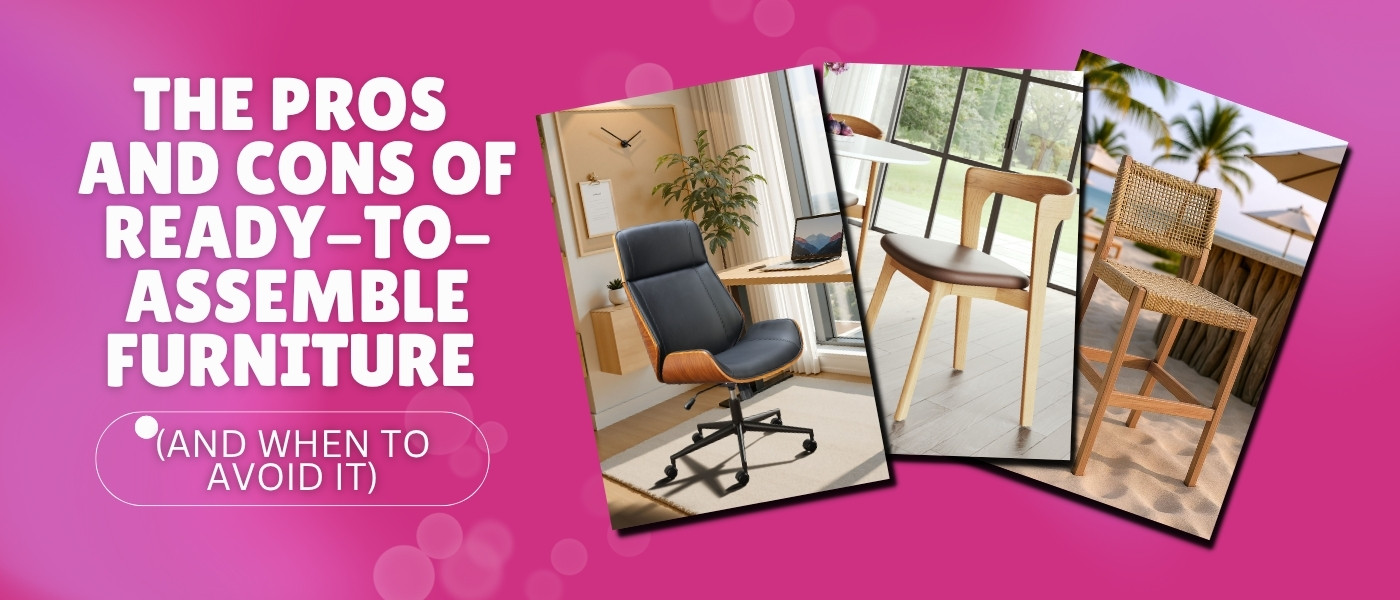The Commodification of Furniture Design in the Age of Direct-to-Consumer and Factory-Supplier Marketplaces
The Commodification of Furniture Design in the Age of Direct-to-Consumer and Factory-Supplier Marketplaces

Over the past decade, the furniture industry has undergone a dramatic transformation. Direct-to-consumer (DTC) brands have promised to cut out the middleman, bringing “designer” furniture straight from the factory to the buyer’s living room at a fraction of the cost. Meanwhile, online marketplaces have exploded with factory suppliers—often overseas—offering seemingly endless styles at astonishingly low prices.
On the surface, this appears to be a golden age for furniture shoppers. Consumers can browse thousands of styles without leaving their sofa, compare prices in seconds, and have trendy pieces delivered directly to their homes in days or weeks. But beneath the convenience lies a structural shift that’s fundamentally altering the value, quality, and meaning of furniture design.
In this new landscape, design is increasingly treated not as a creative discipline but as a disposable commodity. The result is a cycle where trends are copied almost instantly, manufactured at the lowest possible cost, and sold to price-sensitive buyers who often view furniture as short-term decor rather than a long-term investment. Over time, this race for immediacy and affordability has a hidden cost: it cheapens design itself and accelerates how quickly styles fall out of fashion.
1. The Speed of Imitation: How Trends Lose Their Originality Overnight
In the past, a distinctive furniture design might take years to develop, debut at trade shows, and slowly gain recognition in the market. Today, that process has been compressed into weeks or even days.
DTC brands and factory suppliers on marketplaces have built business models that prioritize trend replication over innovation. The moment a style begins gaining traction—perhaps a particular leg shape, a color palette, or a fabric texture—countless near-identical versions appear online.
These copies often sidestep the costs of original design development. Instead of investing in prototyping, ergonomics research, or material sourcing, manufacturers rely on publicly visible product photos or trade show imagery to reproduce a look. While this makes trendy aesthetics more accessible, it also strips away the originality and storytelling that give design its cultural value.
This speed of imitation means no single brand truly owns a design for long. The original creator’s work quickly blends into a sea of indistinguishable products, turning what was once a distinct style into just another thumbnail in a scrolling marketplace feed.
2. The Lowest-Cost Manufacturing Trap
The competitive pressure of online marketplaces doesn’t just accelerate design copying—it forces manufacturing to prioritize cost minimization above all else.
In the quest to undercut competitors by a few dollars, many suppliers reduce expenses in ways that directly impact product quality. Cheaper materials replace higher-grade woods or metals; finishes are thinned to save on application costs; joinery is simplified to reduce labor. Even small compromises—using lower-density foam in cushions or switching to thinner plywood—can drastically shorten a product’s lifespan.
For price-sensitive buyers shopping online, these differences aren’t always obvious before purchase. Photos can make particleboard look like solid oak; lighting and staging can disguise lower-quality finishes. By the time the buyer experiences the compromises firsthand, it’s often too late—or too expensive—to return the item.
Over time, this cycle conditions consumers to expect that “trendy” furniture is inherently disposable. This perception erodes willingness to pay for craftsmanship or durability, further reinforcing the industry’s race to the bottom.
3. The Feedback Loop of Trend Decay
The commodification of design doesn’t just cheapen individual products—it changes how long a style remains desirable.
When a trend is rapidly copied and widely distributed at low cost, it floods the market. Consumers see the same design—whether it’s a boucle accent chair or a walnut-and-black metal coffee table—on Instagram, in online ads, in multiple unrelated stores, and even in big-box retailers.
This overexposure creates trend fatigue. What felt fresh and distinctive six months ago can start to feel generic or even dated in less than a year. And because the low-cost copies often age poorly due to wear and tear, they visually reinforce the idea that the style itself is “cheap” rather than that the manufacturing was subpar.
As a result, brands and suppliers chase the next micro-trend faster than ever, knowing the current one has a short shelf life. This cycle keeps consumers buying, but it also keeps them in a constant state of replacing, rather than curating, their spaces.
4. The Loss of Brand Identity and Differentiation
For furniture brands, the commodification cycle poses a serious challenge: how do you stand out when dozens of competitors are selling nearly identical pieces?
In a DTC or marketplace-driven environment, price becomes the primary differentiator. The subtleties of design intent, material selection, and craftsmanship—which once justified brand loyalty—are flattened by algorithmic search results and side-by-side price comparisons.
Even brands that invest heavily in product photography, lifestyle staging, and marketing often find their images co-opted by copycat listings. This blurs brand identity and undermines the trust that once came from knowing a piece was designed, tested, and built under a specific company’s quality standards.
Without clear differentiation, many brands unintentionally train customers to shop category-first rather than brand-first—a dangerous shift that makes them interchangeable in the buyer’s mind.
5. How Marketplaces Enable Commodification
Large online marketplaces like Amazon, Alibaba, and Wayfair have democratized access to the furniture market, allowing small suppliers to reach millions of potential customers. While this openness has benefits, it also creates fertile ground for commodification.
The platform algorithms often prioritize conversion rates and price competitiveness over originality or quality. Sellers are rewarded for high-volume, low-cost items that move quickly, even if they are trend imitations.
Additionally, the barrier to entry for listing a product is low. A factory can produce a run of a copied design, list it under a generic brand name, and start selling within days—sometimes even using keywords associated with more established brands. This lack of protection for original design work accelerates the erosion of innovation and incentivizes short-term wins over sustainable brand building.
6. The Consumer’s Role in the Cycle
While it’s easy to place the blame entirely on manufacturers and marketplaces, consumer behavior plays a powerful role in reinforcing the commodification loop.
Price sensitivity has become a defining characteristic of online shopping culture. The convenience of comparing dozens of similar-looking products in seconds naturally pushes buyers toward the cheapest option, especially when product descriptions and photos fail to convey the differences in build quality.
The rise of “fast furniture” parallels the fast fashion movement in apparel. Many buyers are comfortable with the idea that furniture might last only a few years before being replaced—especially if it was inexpensive to begin with. This mindset shifts furniture from being a long-term investment to being just another disposable consumer good.
7. The Long-Term Impact on Design Innovation
As more brands and factories chase short-term trends, fewer resources are allocated to genuine design research and development. The result is a market saturated with variations on the same few styles, rather than a diverse, evolving design landscape.
Talented designers may see their work copied before they’ve had a chance to build recognition, reducing the incentive to take creative risks. Over time, this stagnates the industry, with fewer groundbreaking pieces entering the market.
This isn’t just a loss for designers—it’s a loss for consumers as well. When innovation slows, shoppers are left with an endless carousel of safe, familiar designs, often distinguished only by slight variations in shape, color, or finish.
8. Strategies to Break the Cycle
While the commodification of furniture design is a complex challenge, there are ways for brands, retailers, and even consumers to push back:
- Invest in storytelling: Brands that communicate the why behind their designs—highlighting the designer, the craftsmanship, and the materials—can create emotional value that resists price-based commodification.
- Limit channel exposure: Exclusive distribution agreements can help keep designs from flooding marketplaces too quickly, maintaining a sense of scarcity and value.
- Emphasize durability and sustainability: As consumers become more eco-conscious, positioning furniture as a long-term investment rather than a short-term trend can resonate deeply.
- Encourage design literacy: Educating customers on what makes one piece higher quality than another (construction methods, material sourcing, ergonomic design) can shift the focus away from price alone.
9. The Case for a Slower, More Intentional Furniture Market
Breaking free from the commodification loop requires a cultural shift toward valuing originality, quality, and longevity over speed and low cost. For inspiration, the industry can look to slower-moving segments—like custom furniture makers, heritage brands, and high-end design studios—that focus on timeless aesthetics and lasting craftsmanship.
These companies may not release new collections every few months, but when they do, the designs carry a weight of intentionality that resonates with buyers. Pieces are created to outlast fleeting trends, not chase them. While such models may not appeal to every budget, they offer a blueprint for restoring meaning and value to furniture design.
10. Conclusion: Preserving the Value of Design
The rise of direct-to-consumer brands and factory-supplier marketplaces has made furniture more accessible than ever before. But in the rush to democratize style, we risk stripping design of its depth, originality, and longevity.
When trends are instantly commodified, quality is sacrificed for cost, and consumers are trained to view furniture as disposable, the entire industry loses. The path forward lies not in rejecting online retail, but in rebalancing it—valuing innovation as much as efficiency, and recognizing that design is more than just a look.
Furniture, at its best, is a fusion of function, form, and emotional connection. Preserving that vision in an era of instant gratification and mass replication will require conscious effort from brands, platforms, and buyers alike. Only then can design reclaim its place as a lasting part of the spaces we live in, rather than a fleeting thumbnail in an endless scroll.
Email us at hello@zuomod.com with any questions.
Or give us a call at 510-877-4087 (Mon–Fri: 5:00 AM–5:00 PM PT)



